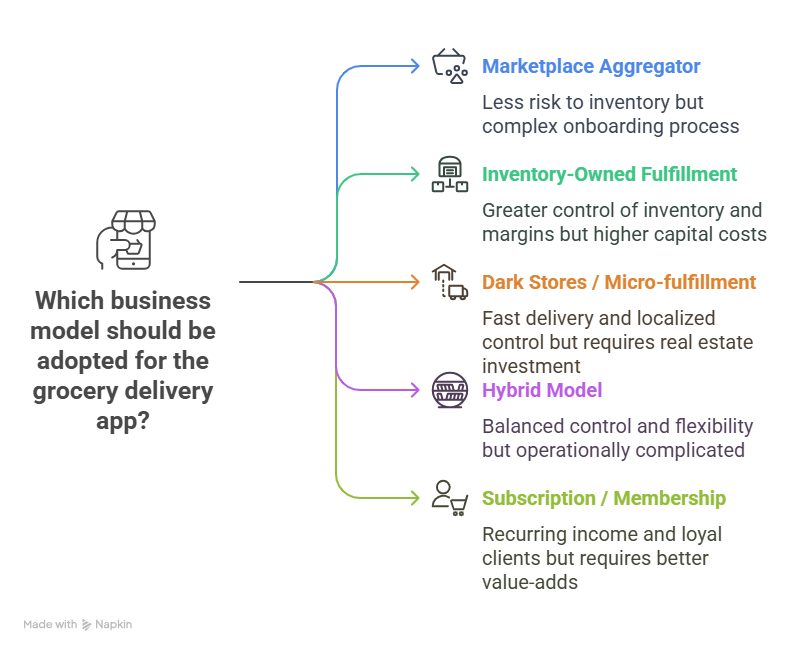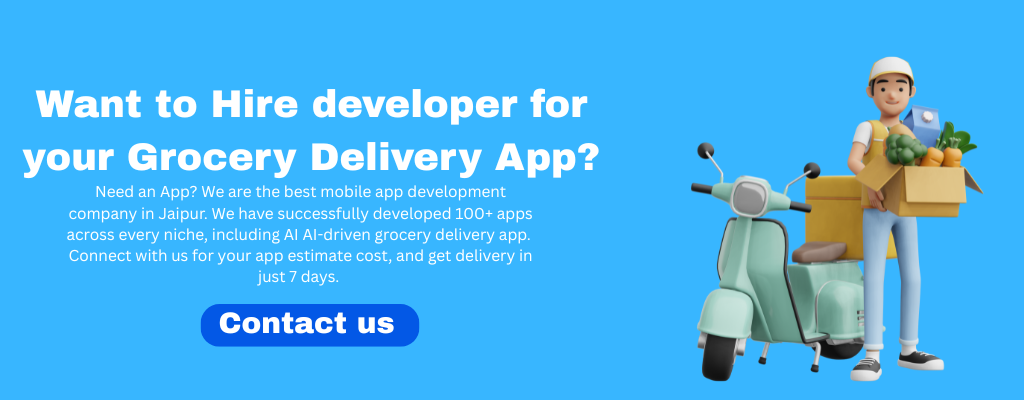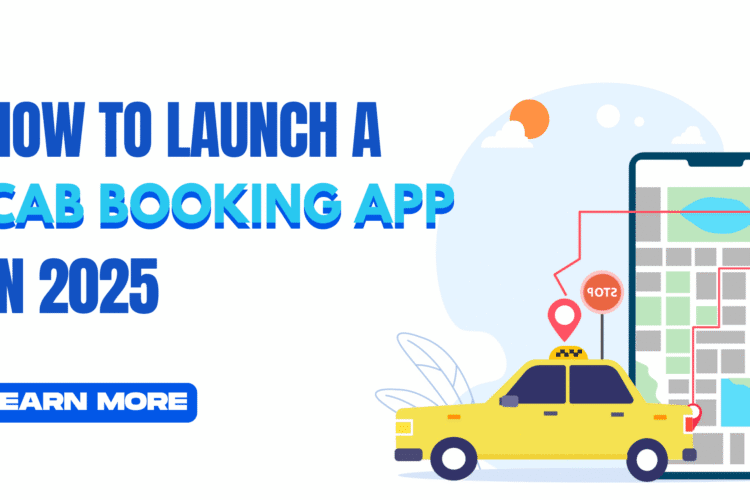
Today, in the digital age, the delivery of groceries isn’t only convenient anymore, but it’s now a must. As expectations for consumers change and supply chain dynamics and mobile-first living, Grocery delivery App development is more essential than ever. As we move closer to 2025, the foundation is all set for entrepreneurs, startup companies, and established brands to build intuitive, reliable, and market-leading grocery apps.
This thorough guide delves into the reasons why 2025 could be the ideal opportunity to introduce the grocery delivery app and explores the business model, AI, and outlines the key features. It analyzes the process of development as well as suggests tech stacks, costs, revenue streams, obstacles, opportunities, and roadblocks. Do you have the skills to design a distinctive solution? Let’s go!
Read Also: Mobile App Development Companies for a grocery delivery app
Why 2025 Is the Prime Time to Launch Your Grocery Delivery App
Post-Pandemic Consumer Habits
The COVID-19 epidemic permanently altered the way people shop. The ease and security of the delivery service at home was a necessity rather than an option. While in-store traffic is increasing however, many customers have remained faithful to their online shopping experiences.
Market Trends Continuing Strong
- The market for online groceries will likely to exceed $1 trillion in 2025 according to numerous analysts.
- Customers expect quicker delivery (often in less than an hour) as well as real-time tracking and more inventory options.
Advancements in AI & Personalization
AI-driven recommendation engines, inventory forecasting, dynamic pricing, and conversational shopping bots are now accessible and critical differentiators–ushering in smarter, more engaging grocery experiences.
Mobile-First Expectations
The number of smartphones on the market continues to increase, especially in regions that are developing. The mobile-first generation demands swift, smooth interactions and an intuitive user interface, which calls for a robust Grocery delivery App development.
New Partnership Opportunities
By 2025, partnerships with dark stores, gig-logistics providers, local grocers, and sustainability-focused suppliers open new verticals and white-label opportunities.
Understanding the Business Models That Work Best
Your company’s business model determines key features, marketing relationships, as well as growth trajectory. Below are some of the most popular models in Grocery delivery App development:

- Marketplace Aggregator
- acts as a middleman, connecting customers to multiple grocery stores.
- Benefits: Less risk to inventory.
- Cons Pros: a complex onboarding process management, accurate inventory.
- Inventory-Owned Fulfillment
- Your warehouse is stocked, you pick and then deliver your goods from your personal warehouse.
- Benefits: Greater control of the inventory as well as margins.
- Cons: More cost of capital, more complicated forecasting.
- Dark Stores / Micro-fulfillment
- Smaller warehouses are located in or close to cities.
- Pros: Fast delivery, localized control.
- Cons: Requires real estate + logistics investment.
- Hybrid Model
- Mixes inventory from stores and exclusive inventory.
- Pros: Balanced control, and the ability to be flexible.
- Pros: Operationally complicated.
- Subscription / Membership
- Customers pay tax-free delivery as well as priority slots and benefits.
- Benefits: Recurring income, loyal clients.
- Pros: Better expectations and value-adds required.
Select a model that is compatible with your budget, risk-taking capacity as well as your tech proficiency. Some 2025-based apps combine models in order to be flexible.
Features That Make a Grocery Delivery App Stand Out in 2025
An effective Grocery delivery App development effort should contain these essential characteristics:
- User Onboarding & Authentication
- Social sign-in, mobile OTP verification, “guest browse” mode.
- Home Screen & Smart Search
- Customized banners, current deals, voice or visual search (scan an item’s barcode).
- Product Catalog & Filtering
- Categorization, quick filters (“organic”, “vegan”, “on-sale”), allergy-safe tags.
- **AI-Driven Recommendations
- Personalized lists of products based upon purchase past history, and dynamic suggestions for upselling.
- Real-Time Availability & Inventory Syncing
- Stock levels live; notification regarding items that are out of stock or for substitutions.
- Cart Management & Substitution Rules
- Suggested replacements, multiple lists, scheduled shopping support.
- Checkout & Payments
- Support for multi-gateways (credit card UPI, wallets BNPL).
- Promo engine, tax computation, split payments.
- Order Tracking & Delivery Slot Booking
- Live map tracking, route ETAs, auto-updates if delayed.
- Jump to “ASAP” options or time-specific windows.
- Dark-Store / Driver Management Dashboard
- Assign orders, track driver and capacity plan.
- Ratings & Reviews
- Both for delivery and products experience. It helps establish trust.
- Admin Panel & Analytics
- Dashboarding (orders as well as inventory and logistics KPIs) Tracking ROI of campaigns.
- Customer Support / Chatbot
- 24/7 chatbot AI that can be escalated to human reps if needed.
- Push Notifications & In-App Messaging
- Offers, abandoned carts orders confirmations, updates on delivery.
- Loyalty & Gamification
- Rewards for birthdays, purchases and referrals. Tiers give you perks.
- Sustainability Features
- Options for eco-friendly delivery, preferred packaging Carbon offset options.
In delivering an excellent UX coupled with powerful backend functions Your grocery delivery app development keeps in front of the pack.
The Step-by-Step Journey of Building a Grocery Delivery App Development
Here is a guideline that will help you with the direction of your Grocery delivery App development from conception to the moment it is launched:
1. Market Research & Validation
- Real-life consumers are interviewed.
- Examine competitors within your targeted area (pricing as well as delivery times).
- Perform MVP Validation of MVP (e.g. Manual-order pilots to measure the level of demand).
2. Choose Your Business Model
- Define the flow of inventory.
- Pinpoint profit per order.
- Validate the logistics partner (dark stores, or gig-drivers hired).
3. Define MVP Scope
- The focus should be on the main flows such as browsing, carts check-out, payment following.
- Restrict UI screen displays (e.g. remove the loyalty feature or AI at first).
- Create an admin/backend to manage orders as well as initial analytics.
4. UX/UI Design
- Design wireframes for consumer as well as driver applications.
- Create with accessibility, mobile first design, and inclusive layouts.
- Testing usability with users who were not yet in the process.
5. Back-end & API Development
- REST or GraphQL APIs.
- Order module, inventory, pricing, payment, user profiles.
- Integrations: Payment gateway and SMS/Push service providers logistic APIs, ERP when appropriate.
6. Driver / Delivery Dashboard
- A lightweight app that can be used for assignments maps, delivery logging and proof of delivery.
7. Testing & QA
- Unit tests for every module.
- Testing of integration (e.g. payment loop, SMS triggers).
- UAT in conjunction with pilots; shadow driver experience.
8. Pilot Launch (Beta)
- Start in restricted areas (e.g. one zone/city) with only a few SKUs.
- Monitoring operational KPIs: the completion of orders, satisfaction with customers Driver performance, customer satisfaction.
9. Rollout, Iterate & Scale
- Make adjustments to the mobile and backend based on the early feedback.
- Expand gradually the geographic areas, SKU catalog, marketing spending.
10. Ongoing Growth
- Add AI recommendations, loyalty modules, regional/localization features.
- Launch Web/PWA, third-party integrations, bigger Partner Networks.
Top Tech Stack Choices for Modern Grocery Delivery App
An efficient and flexible grocery delivery app development package typically comprises:
Front-end
- Mobile React Native, or Flutter (cross-platform effectiveness).
- native: Swift + Kotlin for devices that require a lot of capabilities (voice scan, precision map).
- PWA/Web: React.js or Vue.js and SSR support to aid in SEO.
Back-end
- Languages: Node.js, Python (Django/FastAPI), Java (Spring Boot).
- Frameworks: Express, Nest.js.
- GraphQL is a way to create an incredibly flexible front-end for querying.
Databases
- Primarily: PostgreSQL or MySQL to store structured data.
- NoSQL: Redis to cache data, MongoDB for dynamic / cart information.
- Search Engine: Elasticsearch for fast filters and search capabilities.
Infrastructure & Hosting
- Cloud: AWS, Google Cloud, Azure.
- Services include: AWS Lambda containers (Fargate) ECS/EKS, App Engine.
- CI/CD: GitHub Actions, Bitbucket Pipelines, or GitLab CI.
APIs & Services
- Payments: Stripe, Paypal, Razorpay (India), Braintree.
- Notifications: Twilio, SendGrid, OneSignal.
- Mapping and delivery: Google Maps, Mapbox, HERE; Postmates or local courier APIs.
- AI & Personalization: AWS Personalize, Google ML, TensorFlow.
Analytics & Monitoring
- Segment + Mixpanel + Amplitude for user events.
- Pipelines for data: Kafka plus Google BigQuery and AWS Redshift.
- Logging: ELK Stack, Sentry, Prometheus + Grafana.
Security
- JWT/OAuth2.0, Bcrypt password hashing.
- PCI DSS compliance for payment.
- SOC2 audit framework to support trust.
Read Also: Mobile app development technology stack
Revenue Streams That Make It Profitable
In grocery delivery app development, Profitability comes from diversifying the sources of revenue:
- Delivery Fees
- Fixed rate or variable.
- Costs for premiums on ASAP order.
- Markup on Products
- Price of retail is inflated to gain margin.
- Commissions received from Partners
- Vendors and stores pay a percentage of each purchase.
- Subscription & Membership
- Plans for a year or a month with benefits: Free delivery, special deals.
- Advertising & Promotions
- Brand placements or sponsored products within the application.
- Data Insights and B2B
- Data that is aggregated, anonymous and is sold to FMCG retailers or manufacturers.
- Logistics-as-a-Service
- The replication of your infrastructure for delivery for other clients.
Investment & Development Costs You Should Expect
The process of establishing and launching a top-quality Grocery delivery App development platform for 2025 will require:
| Expense | Approximate Cost (USD) |
| MVP development (3-6 months) | $150K – $300K |
| Dark-store outfitting (per site) | $50K – $150K |
| First-year Operations | $200K – $500K+ |
| Marketing & Customer Acquisition | $100K – $ 500 K+ |
| Maintenance & Support | 15% of the dev budget each year |

Technology stack and outsourcing models can have a significant impact on costs.
- Cloud hosting is scalable with the number of users and orders. $5-20K per month post-pilot.
- Marketing (ads or promotions) is a great way to match development costs for the year 1.
Anticipating Roadblocks & Embracing Opportunities
Inventory Accuracy
- The process of ensuring real-time sync between stock and inventory is a challenge.
- Manage through frequent restocking and smart caching technology as well as manual overrides.
Delivery Delays & Logistics
- Tech issues, traffic, weather can affect ETAs.
- Live route optimization is a must as well as central support for driver.
Subscription Churn
- The key to retention is loyalty. Make use of loyalty-based modules that offer dynamic perks and the use of data-driven targeting.
Scaling Complexity
- SKUs are growing, and more geographical zones increase the complexity.
- Make use of modular microservices, as well as separated database layers.
Marketplace Trust
- Vet and onboard local supermarket suppliers.
- Quality is standardized through review of performance and KPIs for logistics.
Regulatory Compliance
- Privacy, data privacy, taxes for e-commerce food safety.
- Get legal counsel and the compliance auditors on your team from the beginning.
Market Saturation
- The differentiation is achieved through hyper-local focus. exclusive partnerships, private label SKUs and eco-packaging.
Bold Opportunity Zones
- Health and Wellness verticals such as low-sugar, diabet-safe.
- Sustainability: zero-waste deliveries, returnable packaging.
- Tier-2/3 cities: markets that are less digitalized offer greenfield opportunities.
Final Thoughts: Why You Should Begin Now
The intersection of the consumer’s preferences technological maturity and market trends makes it the ideal time to begin Grocery delivery App development. If you choose a good company model, an efficient MVP, an intelligent tech stack as well as a diverse revenue source and flexible roadmap, you’ll create a service that not only fulfills demand, but also shapes the future of grocery shopping.
This is what’s the reason this moment is the best time:
- Consumers: Expect faster, smarter, safer delivery.
- Technology: AI, micro-fulfillment, PWA, 5G are ready for mainstream use.
- Competitors: Many runners still have a long way to go in terms of discovery, reliability and personalization.
- Investors The interest on financing is very high for profit-based grocery technology.
Quick Recap
- 2025 is a good year when consumer behaviour meets the technical requirements.
- High-impact features: search, AI, real-time inventory, loyalty.
- The smart tech stack Front-end that is cross-platform, modern microservices, cloud native.
- Revenue Markup + Fees + advertisements + subscriptions the data.
- Costs Budget for $500K-$1Mand the initial year.
- Obstacles Logistics, inventory and trust. Compliance is also a big issue. of possibilities.
Your Next Moves
- Begin MVP scope and choose your model of business.
- Pilot test using a micro-market (one dark-store, or partner grocery store).
- The development process is gradual, with a focus on the automation process and personalization.
- Grow with data-driven marketing, and loyalty, fuelled by real-time feedback.
The bottom line is that Grocery delivery App development isn’t just a profitable trend but is becoming an essential service. Develop smartly, get it up and running and adapt swiftly, and you’ll become the next big name in the market.

Are you ready to transform this into a profitable application? Save this guide and adapt it to the region you live in and your capabilities, then get started today!


